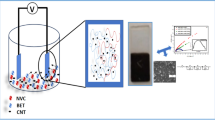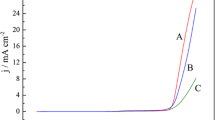Abstract
An electrochromic copolymer film of 2-(3,3-dihexyl-3,4-dihydro-2H-thieno[3,4-b][1,4]dioxepin-6-yl)-7-(3,3-dihexyl-3,4-dihydro-2H-thieno[3,4-b][1,4]dioxepin-8-yl)-9H-carbazole (M1) and 4,7-bis(thiophen-2-yl)benzo[c][1,2,5]thiadiazole (M2) was prepared via electrochemical technique. The copolymerization was performed with one to one monomer feed ratio. Electrochemical and optical properties of the resulting copolymer film (P3) and the homopolymer films of M1 and M2 (P1 and P2) were investigated by using cyclic voltammetry and UV-Vis spectrometry techniques, and the corresponding results were compared. Incorporation of M1 and M2 into copolymer matrix was clearly observed on the resulting cyclic voltammograms and UV-Vis spectra. P3 covered the visible regions coming from both P1 and P2, and exhibited a neutral state darker color than those of homopolymers. P3 film was found to have a multichromic behavior, appearing as brown in its neutral state while changing its color upon oxidation to dark-gray (at about 0.3 V), to blue (at about 0.6 V) and finally to grayish cyan (beyond 0.9 V), with a corresponding optical band gap of 1.65 eV.
Similar content being viewed by others
References
Pennisi, A.; Simone, F.; Barletta, G.; Di Marco, G.; Lanza, L. Preliminary test of a large electrochromic window. Electrochim. Acta 1999, 44, 3237–3243.
Rauh, R. Electrochromic windows: an overview. Electrochim. Acta 1999, 44, 3165–3176.
Mortimer, R. G. Electrochromic materials. Chem. Soc. Rev. 1997, 26, 147–156.
Argun, A. A.; Aubert, P. H.; Thompson, B. C.; Schwendeman, I.; Gaupp, C. L.; Hwang, J.; Pinto, N. J.; Tanner, D. B.; MacDiarmid, A. G.; Reynolds, J. R. Multicolored electrochromism in polymers: structures and devices. Chem. Mater. 2004, 16, 4401–4412.
Mortimer, R. J.; Dyer, A. L.; Reynolds, J. R. Electrochromic organic and polymeric materials for display applications. Displays 2006, 27, 2–18.
Bradley, D. D. C. Conjugated polymer electroluminescence. Synt. Met. 1993, 54, 401–415.
Kelly, F. M.; Meunier, L.; Cochrane, C.; Koncar, V. Polyaniline: application as solid state electrochromic in a flexible textile display. Displays 2013, 34, 1–7.
Lee, K.; Povlich, L. K.; Kim, J. Recent advances in fluorescent and colorimetric conjugated polymer-based biosensors. Analyst 2010, 135, 2179–2189.
Dance, Z. E. X.; Ahrens, M. J.; Vega, A. M.; Ricks, A. B.; McCamant, D. W.; Ratner, M. A.; Wasielewski, M. R. Direct observation of the preference of hole transfer over electron transfer for radical ion pair recombination in donor-bridge-acceptor molecules. J. Am. Chem. Soc. 2008, 130, 830–832.
Sonmez, G.; Sonmez, H. B.; Shen, C. K. F.; Jost, R. W.; Rubin, Y.; Wudl, F. A processable green polymeric electrochromic. Macromolecules 2005, 38, 669–675.
Zhou, H.; Yang, L.; Stuart, A. C.; Price, S. C.; Liu, S.; You, W. Development of fluorinated benzothiadiazole as a structural unit for a polymer solar cell of 7% efficiency. Angew. Chem. 2011, 50, 2885–2998.
Song, S.; Jin, Y.; Kim, S. H.; Shim, J. Y.; Son, S.; Kim, I.; Lee, K.; Suh, H. Synthesis and characterization of polyfluorenevinylene with cyano group and carbazole unit. J. Polym. Sci., Part A: Polym. Chem. 2009, 47, 6540–6551.
Froehlich, J. D.; Young, R.; Nakamura, T.; Ohmori, Y.; Li, S.; Mochizuk, A. Synthesis of multi-functional POSS emitters for OLED applications. Chem. Mater. 2007, 19, 4991–4997.
Usta, H.; Facchetti, A.; Marks, T. J. Air-stable, solution-processable n-channel and ambipolar semiconductors for thin-film transistors based on the indenofluorenebis(dicyanovinylene) core. J. Am. Chem. Soc. 2008, 130, 8580–8581.
Yang, C.; Kim, J. Y.; Cho, S.; Lee, J. K.; Heeger, A. J.; Wudl, F. Functionalized methanofullerenes used as n-type materials in bulk-heterojunction polymer solar cells and in field-effect transistors. J. Am. Chem. Soc. 2008, 130, 6444–6450.
Malitesta, C.; Losito, I.; Zambonin, P. G. Molecularly imprinted electrosynthesized polymers: new materials for biomimetic sensors. Anal. Chem. 1999, 71, 1366–1370.
John, R.; Spencer, M.; Wallace, G. G.; Smyth, M. R. Development of a polypyrrole-based human serum albümin sensor. Anal. Chim. Acta 1991, 249, 381–385.
Duan, C.; Huang, F.; Cao, Y. Recent development of push-pull conjugated polymers for bulk-heterojunction photovoltaics: rational design and fine tailoring of molecular structures. J. Mater. Chem. 2012, 22, 10416–10434.
Zhou, H.; Yang, L.; You, W. Rational design of high performance conjugated polymers for organic solar cells. Macromolecules 2012, 45, 607–632.
Durmus, A.; Gunbas, G.; Camurlu, P.; Toppare, L. A neutral state green polymer with a superior transmissive light blue oxidized state. Chem. Commun. 2007, 3246–3248.
Durmus, A.; Gunbas, G.; Toppare, L. New, highly stable electrochromic polymers from 3,4-ethylenedioxythiophene—bissubstituted quinoxalines toward greeen polymeric materials. Chem. Mater. 2007, 19, 6247–6251.
Mei, J.; Bao, Z. Side chain engineering in solution processable conjugated polymers. Chem. Mater. 2014, 26, 604–615.
Kularatne, R. S.; Magurudeniya, H. D.; Sista, P.; Biewer, M. C.; Stefan, M. C. Donor-acceptor semiconducting polymers for organic solar cells. J. Polym. Sci., Part A: Polym. Chem. 2013, 51, 743–768.
Hardeman, T.; Koeckelberghs, G. Synthesis of conjugated polymers by combining different coupling reactions. Polym. Chem. 2017, 8, 3999–4004.
Xie, R.; Chen, Z.; Zhang, G.; Huang, Y.; Ying, L.; Huang, F.; Cao, Y. Synthesis and characterization of p-conjugated copolymers based on alkyltriazolyl substituted benzodithiophene. New J. Chem. 2016, 40, 4727–4734.
Akbayrak, M.; Cansu-Ergun, E. G.; Onal, A. M. Synthesis and electro-optical properties of a new copolymer based on EDOT and carbazole. Des. Monomers Polym. 2016, 19, 679–687.
Nie, G.; Qu, L.; Xu, J.; Zhang, S. Electrosyntheses and characterizations of a new soluble conducting copolymer of 5-cyanoindole and 3,4-ethylenedioxythiophene. Electrochim. Acta 2008, 53, 8351–8358.
Aydın, A.; Kaya, I. Syntheses and characterization of yellow and green light emitting novel polymers containing carbazole and electroactive moieties. Electrochim. Acta 2012, 65, 105–114.
Aydın, A.; Kaya, I. Syntheses of novel copolymers containing carbazole and their electrochromic properties. J. Electroanal. Chem. 2013, 691, 1–12.
Ates, M.; Uludag, N. Carbazole derivative synthesis and their electropolymerization. J. Solid State Electrochem. 2016, 20, 2599–2612.
Carbas, B. B. Novel electrochromic copolymers based on 3-3′-dibromo-2-2′bithiophene and 3,4-ethylenedioxythiophene. Polymer 2017, 113, 180–186.
Zhou, W.; Xu, J.; Wei, Z.; Pu, S. Electrochemical copolymerization of dibenzofuran and 3-methylthiophene in boron trifluoride diethyl etherate. Chinese J. Polym. Sci. 2008, 26, 81–90.
Cansu-Ergun, E. G.; Onal, A. M. Carbazole based electrochromic polymers bearing ethylenedioxy and propylenedioxy scaffolds. J. Electroanal. Chem. 2018, 815, 158–165.
Cansu-Ergun, E. G.; Akbayrak, M.; Akdag, A.; Onal, A. M. Effect of thiophene units on the properties of donor-acceptor type monomers and polymers bearing thiophene-benzothiadiazolescaffolds. J. Electrochem. Soc. 2016, 163, 153–158.
Zhao, H. P.; Tao, X. T.; Wang, F. Z.; Ren, Y.; Sun, X. Q.; Yang, J. X.; Yan, Y. X.; Zou, D. C.; Zhao, X.; Jiang, M. H. Structure and electronic properties of triphenylamine-substituted indolo[3,2-b]carbazole derivatives as hole-transporting materials for organic light-emitting diodes. Chem. Phys. Lett. 2007, 439, 132–137.
Bakalis, J.; Cook, A. R.; Asaoka, S.; Forster, M.; Scherf, U.; Miller, J. R. Polarons, compressed polarons and bipolarons in conjugated polymers. J. Phys. Chem. C 2014, 118, 114–125.
Kumar, A.; Welsh, D. M.; Morvant, M. C.; Piroux, F.; Abboud, K. A.; Reynolds, J. R. Conducting poly(3,4-alkylenedioxythiophene) derivatives as fast electrochromics with high contrast ratios. Chem. Mater. 1998, 10, 896–902.
Beaujuge, P. M.; Reynolds, J. R. Color Control in p-conjugated organic polymers for use in electrochromic devices. Chem. Rev. 2010, 110, 268–320.
Acknowledgments
I would like to thank and appreciate Prof. Dr. Ahmet Muhtar Onal (Department of Chemistry, Middle East Technical University, Turkey) for his academic guidance and support.
Author information
Authors and Affiliations
Corresponding author
Rights and permissions
About this article
Cite this article
Cansu-Ergun, E.G. Covering the More Visible Region by Electrochemical Copolymerization of Carbazole and Benzothiadiazole Based Donor-Acceptor Type Monomers. Chin J Polym Sci 37, 28–35 (2019). https://doi.org/10.1007/s10118-019-2181-8
Received:
Accepted:
Published:
Issue Date:
DOI: https://doi.org/10.1007/s10118-019-2181-8




